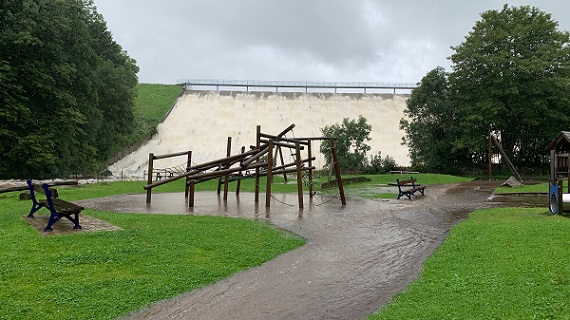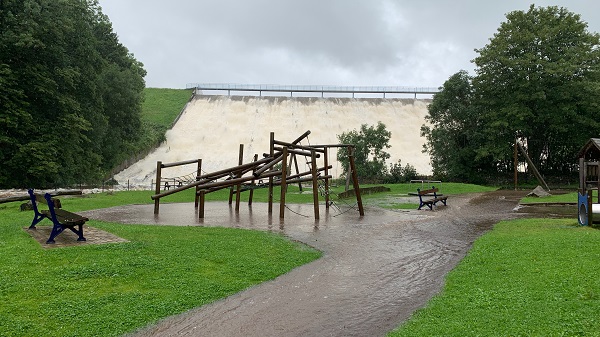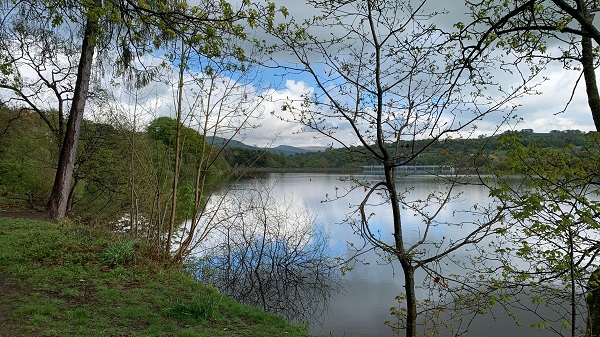
September 16, 2019, by Blue-Green team
Toddbrook Reservoir – A Case of Dam Charity or Charity be Damned?
Lessons are being drawn from the near breach of Toddbrook reservoir dam concerning the vulnerability of the UK’s infrastructure to extreme events. Karen Potter reflects on the implications of the risk, liability and responsibility of ‘Toddbrooks’ being devolved to civil society.
Flood risk and emergency response
On August 1st 2019 approximately 1,500 residents in the Derbyshire town of Whaley Bridge were instructed to evacuate their homes, after the nearby Toddbrook reservoir dam threatened to breach following a period of extreme rainfall (Broomhead, 2019; Pidd et al., 2019). According to the incident commander, it had been a very, very tense night and a near miss from dam failure (Parveen, 2019).
A round-the-clock, multi-agency emergency response averted any disaster. This included the Derbyshire Constabulary, Fire and Rescue Service, the Environment Agency, Derbyshire County Council (e.g. the Emergency Planning Officers), High Peak District Council, the Canal and River Trust, and everyone who supported the people of Whaley Bridge and surrounding areas with the evacuation. With the aid of an RAF Chinook helicopter over 500 hundred bags of aggregate were dropped to reinforce the dam wall, and over the course of a week the reservoir’s water levels were drawn down by over ten metres until almost empty (Jowitt, 2019). The emergency services, military personnel, Environment Agency and volunteers were praised by the media and Government for their heroic effort, and many tributes have been paid to the wonderful community support, spirit and fortitude in Whaley Bridge (Defra et al., 2019). Residents were allowed to return to their homes a week later, and the focus has now turned from the emergency response to the Secretary of State’s (Theresa Villiers) commissioned review, which is set to investigate “what might have led to the damage, whether there was anything that could have prevent or predicted it and identify any lessons learned” (Hansard, 03 September 2019).
Identifying lessons learned – missing the governance implications?
Experts assert the main lesson from the Whaley Bridge dam scare is that the maintenance of dam spillways cannot be ignored, in any circumstances or at any cost (Heidarzadeh, 2019).
The incident has also been taken as a broader warning that the UK’s infrastructure is not up to scratch in the face of climate change and the Government is not acting quickly enough or committing enough resources to upgrade it (Weaver and Laville, 2019). The Government has consequently faced calls for an urgent overhaul of flood defences and water infrastructure and to put climate resilience at the top of the spending list (ibid).
What has not yet been highlighted or debated to any extent following the scare, is that the ownership of Toddbrook Reservoir lies with a charity – the Canal and River Trust. Should a charity take on this level of risk, liability and responsibility for the maintenance and upgrading of major infrastructure? If so, will the raising of climate resilience to the top of the Canal and River Trust’s list come with a serious commitment to increased support and resources from Government?
The creation of a new charity at the heart of our Civil Society
“The creation of a new charity will place the waterways firmly at the heart of civil society” (Defra, 2011, p1)
The Canal and River Trust protects the nation’s heritage, with 3,200km of historic canals and river navigations in England & Wales, more than 1,580 locks, 2980 bridges, 758 major embankments, 1,931 culverts, 73 pumping stations, 4 tidal ports, 335 aqueducts (Comerford, 2016; CRT, 2019) and 72 more reservoirs beyond Toddbrook.
The Canal and River Trust was launched as a charity in July 2012, the first major and flagship transfer of a public body (British Waterways) into the charitable or third sector. State ownership was asserted to limit the network’s ability to adapt and innovate. A new civil society organisation was established, believed to unlock the full potential of the waterways to thrive in the future and increase the role of local communities in helping to decide how their local canal or river is run (Defra, 2011). A ‘steering’ state can indeed enable communities to generate beneficial outcomes that are beyond the reach of government alone. But as Rolfe (2017) stresses, the Government rhetoric surrounding localism focuses largely on the devolution of power, with less frequent mentions of the responsibilities, risk and financial liabilities that come with these opportunities.
Growing vulnerability of inland navigation to extreme events
A huge volume of water had poured down through the Derbyshire Peak District hills swelling the Toddbrook reservoir’s water level to the dam’s crest on August 1st, then cascading onto the concrete spillway (Heidarzadeh, 2019). Concrete spillways are ordinarily designed to allow a safe and controlled release of excessive flood waters and protect otherwise vulnerable earthfill dams, but on this occasion it started to erode and collapse under the torrent of water (ibid). Installed in 1969, the 50 year old ‘thin grey line of concrete’ protecting the town of Whaley Bridge had reached the end of its life (Heidarzadeh, 2019). If the dam burst, 1.22 megalitres of water from the reservoir had threatened to engulf over 400 homes and businesses in parts of Whaley Bridge 0.5km below, and other areas downstream along the River Goyt, under as much as two metres of water (Pidd et al., 2019).

Water rushing down the Toddbrook dam spillway prior to the evacuation of Whaley Bridge. Photo credit: David Lee.
Toddbrook Reservoir, built in 1831, has now been discussed in the global context of ageing dams not designed for ever more extreme rainfall, already unsafe and in need of upgrading (Le Page, 2019). Brooke (2014) has already detailed how Britain’s inland navigation is particularly vulnerable to extreme events, being less able to accommodate the effects of climate change as the network relies on older infrastructure designed for pre-climate change conditions. Embankments may be overtopped more frequently or damaged by high flows; piling or other forms of bank protection may be more susceptible to washing out and to erosion. Low flows can also cause serious implications for the structural integrity of navigation infrastructure, due mainly to the removal of hydraulic support from the waterside face (Brooke, 2014). Brooke concludes climate change could prove costly as inland navigation authorities are likely to have to replace, upgrade or retrofit infrastructure, particularly when the historically low investment levels in much of the inland waterway network are also taken into account (ibid).
Our ‘heritage’ and ‘amenity’ also means ageing infrastructure
British Waterways had been carrying risks related to the condition of ageing infrastructure for many years prior to its charitisation (Lloyd et al., 2009). A report commissioned from KPMG (2008) estimated there was a funding gap of at least £29m per annum between British Waterways’ income stream and the cost of maintaining and preventing further deterioration of the two hundred year old waterways and network assets waterways (including reservoirs, locks, bridges, embankments, aqueducts and cuttings) (in Lloyd et al., 2009). If the British Waterways network was retained in the public sector, the proportion of its navigation assets in poor or very poor condition was projected to almost double by the middle of the next decade, creating a major backlog of repairs and safety maintenance (ibid, 2009). Such a trajectory was thought to create “very substantial and ever-increasing risks to public safety, as well as to the long-term amenity benefits that the waterways bring” (ibid, 2009, p20).
British Waterways was experiencing regular failures of its embankments, with a total of 51 breaches experienced between 2000 and 2009. In 2009, following the global financial crisis, further efficiency savings were announced by the Government, including a cut of another £10m from British Waterways’ existing grant of £57.5m. The Inland Waterways Association stated that the proposed cuts would exacerbate an already critical situation (ibid, 2009).
A devolution of responsibility, risk and financial liability…..
The major driver for the Government’s transfer of British Waterways’ to a charity was to provide new freedoms and strong incentives to bring in new revenue streams, including legacies and donations to fund the operation and maintenance of the waterways. Along with notions of supporting localism and enabling closer involvement of communities, the Government stated key investment objectives were: to foster Canal and River Trust’s increasing self-reliance; to move the long term cost of maintenance from the public sector to civil society and the avoidance of additional unpredictable costs to taxpayers (Lloyd et al., 2009). The Funding Agreement was also said to avoid the most significant risks of an underfunded network in which health and safety risks increased as assets deteriorated and were susceptible to failure (Defra, 2012a).
Defra detailed the grant funding over a 15-year contract to March 2027: a core grant from 2012/13, £39m p.a. index linked on a three-yearly cycle from 2015/16, conditional funding from 2015/16, £10m p.a. not index-linked and reduced gradually over the last five years of the contract to a minimum of £4m (Defra, 2015). There were immediate concerns expressed regarding the adequacy of the proposed funding package from Government and that the projections of voluntary income were over optimistic in the light of the current economic climate (Defra, 2012a, p13). Amendments may be proposed for mutual consideration whenever either party considers this necessary but Defra is under no obligation to increase the amount or to extend the Grant beyond the end of the term (Defra, 2012b). A review will take place in 2021 to 2022 to examine the public benefit case for the Government’s funding of the waterways, also stated to include a consideration of any unintended consequences and whether government intervention is still required going forward (Defra, 2015).
…..or continued shared responsibility for Whaley Bridge and any other communities at risk?
In 2012, the Canal and River Trust took on the responsibility of the heritage assets of British Waterways in England and Wales. The Canal and River Trust also took on the growing liabilities and risk of serious breaches and potential flood risk from British Waterways and the taxpayers in England and Wales. Evidence from other studies of ‘localism’ initiatives have suggested that the language of devolving power has been a false carrot from government, tempting communities to take on greater responsibilities for tackling social issues, but deliberately devolving risk and outsourcing blame (Rolfe, 2017).
Meanwhile, the Canal and River Trust report that independent experts have been appointed to carry out the investigation into what caused the damage to the Toddbrook dam spillway.
We are navigating unchartered governance waters. Will it be all hands on deck for civil society, a blame game and Canal and River Trust cut adrift, or will we see the Government firmly at the helm, retaining responsibility for the future of our communities potentially at risk from climate change?
Photographs courtesy of David Lee.
References:
British Waterways (2008), British Waterways Status Options Review (Report by Consultants KPMG, June 2008).
Brooke, J. (2014) ‘Working Technical Paper Transport: Inland Waterways, Ports and Marine Infrastructure’. Available at: https://nerc.ukri.org/research/partnerships/ride/lwec/report-cards/infrastructure-source03/ (Accessed: 30 August 2019).
Broomhead, M. (2019) ‘Toddbrook Reservoir owners move to reassure Whaley Bridge residents after heavy rain’, Buxton Advertiser, 17 August. Available at: https://www.buxtonadvertiser.co.uk/news/toddbrook-reservoir-owners-move-to-reassure-whaley-bridge-residents-after-heavy-rain-1-9941490 (Accessed: 30 August 2019).
Canal & River Trust (2018) ‘About us’, Canal & River Trust. Available at: https://canalrivertrust.org.uk/about-us (Accessed: 30 August 2019).
Comerford, A. (2016) ‘Climate change resilience for inland waterways – the Canal & River Trust approach’ [PowerPoint presentation] Available at: http://www.pianc.org.uk/documents/seminars/07Mar16/07Mar16-PIANC-Adam-Comerford.pdf (Accessed: 30 August 2019).
Defra (2011) ‘Summary of responses to the consultation ‘A New Era for the Waterways’, 30th March – 30th June 2011’. Available at: http://www.legislation.gov.uk/uksi/2012/1659/pdfs/uksiod_20121659_en.pdf (Accessed: 30 August 2019).
Defra (2012a) ‘Grant agreement between the Secretary of State for Environment, Food and Rural Affairs and Canal & River Trust’ Available at: https://assets.publishing.service.gov.uk/government/uploads/system/uploads/attachment_data/file/183235/Canal-rivers-grant-agreement.pdf (Accessed: 30 August 2019).
Defra (2012b) ‘The Secretary of State for Environment, Food and Rural Affairs and Canal & River Trust Memorandum of Understanding’. Available at: https://assets.publishing.service.gov.uk/government/uploads/system/uploads/attachment_data/file/183230/Canal-rivers-MOU.pdf (Accessed: 30 August 2019).
Defra (2015) ‘2010 to 2015 government policy: access to the countryside. Appendix 2: funding the Canal & River Trust’. Available at: https://www.gov.uk/government/publications/2010-to-2015-government-policy-access-to-the-countryside/2010-to-2015-government-policy-access-to-the-countryside#appendix-2-funding-the-canal–river-trust (Accessed: 30 August 2019).
Defra, EA and The Rt Hon Theresa Villiers (2019) ‘Environment Secretary Theresa Villiers visits Whaley Bridge’, [Press Release]. Available at: https://www.gov.uk/government/news/environment-secretary-theresa-villiers-visits-whaley-bridge (Accessed: 30 August 2019).
Heidarzadeh, M. (2019) Whaley Bridge dam collapse is a wake-up call: concrete infrastructure will not last forever without care. The Conversation, 5th August 2019. https://theconversation.com/whaley-bridge-dam-collapse-is-a-wake-up-call-concrete-infrastructure-will-not-last-forever-without-care-121423 (Accessed 30th August 2019).
HC Deb (03 September 2019) vol. 664. Available at: https://hansard.parliament.uk/commons/2019-09-03/debates/19090310000012/SummerFloodingAndReservoirReview (Accessed: 17 September 2019).
Jowitt, R. (2019) ‘Toddbrook Reservoir update’. Canal and River Trust, 28 August. Available at: https://canalrivertrust.org.uk/news-and-views/news/toddbrook-reservoir-update (Accessed: 30 August 2019).
Parveen, N. (2019) ‘The dam very nearly went’: the scramble to save Whaley Bridge’. The Guardian, 5 August. Available at: https://www.theguardian.com/uk-news/2019/aug/01/uk-weather-homes-evacuated-floods-hit-north-of-england (Accessed: 5 August 2019).
Pidd, H., Gayle, D. and Greenfield, P. (2019) ‘Peak District town evacuated as dam threatens to burst’, The Guardian, 2 August. Available at: https://www.theguardian.com/uk-news/2019/aug/01/uk-weather-homes-evacuated-floods-hit-north-of-england (Accessed: 30 August 2019).
Weaver, M. and Laville, S. (2019) ‘Whaley Bridge dam: heed flood defence warning, experts urge’. The Guardian, 2 August. Available at: https://www.theguardian.com/environment/2019/aug/02/heed-flood-defence-warning-from-whaley-bridge-dam-scare-experts-urge (Accessed: 30 August 2019).
Le Page, M. (2019) ‘The world’s ageing dams are not built for ever more extreme weather’. New Scientist, 2 August. Available at: https://www.newscientist.com/article/2212427-the-worlds-ageing-dams-are-not-built-for-ever-more-extreme-weather/#ixzz5y6Y6ykgF (Accessed: 30 August 2019).
Lloyd, S., Hudson, M. and Bennett, M. (2009) ‘Setting a new course Britain’s waterways in the third sector’, British Waterways, November 2009. Available at: https://www.compasspartnership.co.uk/pdf/BWSNC.pdf
Rolfe, S. (2017) ‘Governance and Governmentality in Community Participation: The Shifting Sands of Power, Responsibility and Risk’. Social Policy and Society, 17, 579-598.


An article in Ground Engineering Magazine suggests that Canal & River Trust were aware of potential problems with the spillway more than three months before it failed.
Just over a year ago, there was a major breach of the Trusts embankment at Middlewich (now repaired at a cost of £3m). It was subsequently found that that CRT had failed to act on recommendations from its own inspection report which required the raising of the embankment freeboard and washwall.
Karen, well said, one wonders if the inquiry will have the guts to challenge Government or if it once again will not be allowed to speak truth to power? I think it’s led by David Balmforth, so it may come out OK. Having experienced the problems faced by the C&RT personally on a canal boat recently, it is clear that they are struggling to cope. With government decreasing expenditure on FRM, we have to expect a major disaster in the near future. By then it will be a different government (one hopes), but they doubtless will be blamed for this legacy of incompetence and carelessness.
A very interesting and useful article. Is the Heidarzadeh, 2019 reference missing?
Thanks Ed, it was indeed missing but has now been included in the reference list (see also https://theconversation.com/whaley-bridge-dam-collapse-is-a-wake-up-call-concrete-infrastructure-will-not-last-forever-without-care-121423)
Why have you not mentioned the response of the Derbyshire County Council Emergency Planning Officers and the High Peak District Council, and those who supported the people of Wayley Bridge and surrounding areas regarding the Evacuation .? ? ✔️ ✔️
Thanks Paul, we have amended the blog post to include the organsations and people who supported the evacuation, as you suggested. If we have missed out any other groups then please let us know.
Thanks Richard. Yes, this is why I wanted to raise an alternative voluntary sector/civil society perspective – before or in case, as you say ‘they doubtless will be blamed’.